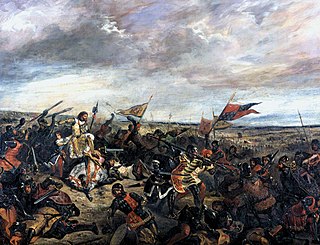
The Battle of Poitiers was fought on 19 September 1356 between a French army commanded by King John II and an Anglo-Gascon force under Edward, the Black Prince, during the Hundred Years' War. It took place in western France, 5 miles (8 km) south of Poitiers, when approximately 14,000 to 16,000 French attacked a strong defensive position held by 6,000 Anglo-Gascons.

The Battle of Agincourt was an English victory in the Hundred Years' War. It took place on 25 October 1415 near Azincourt, in northern France. The unexpected English victory against the numerically superior French army boosted English morale and prestige, crippled France, and started a new period of English dominance in the war that would last for 14 years until France defeated England in the Siege of Orléans in 1429.

The Battle of Crécy took place on 26 August 1346 in northern France between a French army commanded by King Philip VI and an English army led by King Edward III. The French attacked the English while they were traversing northern France during the Hundred Years' War, resulting in an English victory and heavy loss of life among the French.
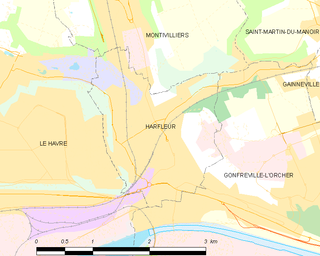
The siege of Harfleur was conducted by the English army of King Henry V in Normandy, France, during the Hundred Years' War. The defenders of Harfleur surrendered to the English on terms and were treated as prisoners of war. It was the first time that an English army made significant use of gunpowder artillery in the siege of a large urban settlement.
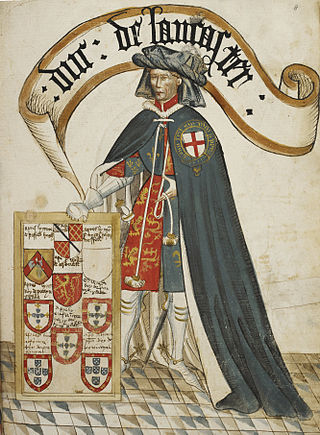
Henry of Grosmont, Duke of Lancaster was an English statesman, diplomat, soldier, and Christian writer. The owner of Bolingbroke Castle in Lincolnshire, Grosmont was a member of the House of Plantagenet, which was ruling over England at that time. He was the wealthiest and most powerful peer of the realm.
A chevauchée was a raiding method of medieval warfare for weakening the enemy, primarily by burning and pillaging enemy territory in order to reduce the productivity of a region, in addition to siege warfare most often as part of wars of conquest but occasionally as a punitive raid. The use of the chevauchée declined at the end of the 14th century as the focus of warfare turned to sieges. It is conceptually similar to the scorched earth strategies used in modern warfare.
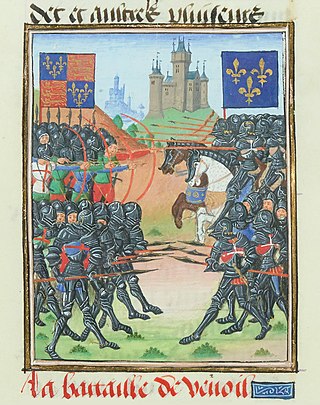
The Battle of Verneuil was a battle of the Hundred Years' War, fought on 17 August 1424 near Verneuil-sur-Avre in Normandy between an English army and a combined Franco-Scottish force, augmented by Milanese heavy cavalry. The battle was a significant English victory, and was described by them as a second Agincourt.

The Battle of Blanchetaque was fought on 24 August 1346 between an English army under King Edward III and a French force commanded by Godemar du Fay. The battle was part of the Crécy campaign, which took place during the early stages of the Hundred Years' War. After landing in the Cotentin Peninsula on 12 July, the English army had burnt a path of destruction through some of the richest lands in France to within 20 miles (32 km) of Paris, sacking a number of towns on the way. The English then marched north, hoping to link up with an allied Flemish army which had invaded from Flanders. They were outmanoeuvred by the French king, Philip VI, who garrisoned all of the bridges and fords over the River Somme and followed the English with his own field army. The area had previously been stripped of food stocks by the French, and the English were essentially trapped.
The Battle of Lunalonge was fought in the summer of 1349 between a French force numbering approximately 1,500 men and an Anglo-Gascon force of some 500 men, during the first phase of the Hundred Years' War. The location of the battle is thought to have been modern Limalonges in Deux-Sèvres. The outnumbered Anglo-Gascons, commanded by Thomas Coke, gained the upper hand during the day, but had to withdraw on foot during the night because the French, under Jean de Lille, had captured their horses. The French lost approximately 300 killed and an unknown but large number captured, including their leader.
The Battle of Auberoche was fought on 21 October 1345 during the Gascon campaign of 1345 between an Anglo-Gascon force of 1,200 men under Henry, Earl of Derby, and a French army of 7,000 commanded by Louis of Poitiers. It was fought at the village of Auberoche near Périgueux in northern Aquitaine. At the time, Gascony was a territory of the English Crown and the "English" army included a large proportion of native Gascons. The battle resulted in a heavy defeat for the French, who suffered very high casualties, with their leaders killed or captured.

The Battle of Morlaix was a battle fought in Morlaix on 30 September 1342 between the Anglo-Breton and Franco-Breton forces in Brittany. The Anglo-Breton under English command besieged the town, but a Franco-Breton relief force arrived. The English constructed a strong defensive position. After repeated attacks, the French forced the English to retreat into the woods, and the French force then withdrew.

The Battle of Caen was an assault conducted on 26 July 1346 by forces from the Kingdom of England, led by King Edward III, on the French-held town of Caen and Normandy as a part of the Hundred Years' War.

The Battle of Saint-Omer, fought on 26 July 1340, was a major engagement in the early stages of the Hundred Years' War, during Edward III's 1340 summer campaign against France launched from Flanders. The campaign was initiated in the aftermath of the English naval victory at the Battle of Sluys but was far less successful than Edward had hoped. At Saint-Omer, the heavily-outnumbered French men-at-arms, tasked with defending the city and awaiting reinforcements, unexpectedly defeated the Anglo-Flemish forces on their own. The allies suffered heavy losses and the French captured their camp intact, taking many warhorses, draft animals and carts, all the tents, huge quantities of supplies and most of the Flemish standards. Edward's campaign of 1340 had begun badly. On the bright side, the loss of several thousand men was bearable, as the survivors, which included most of the precious English longbowmen, eventually rejoined him at Tournai. The defeat had serious strategic consequences. It exposed southern Flanders to the wrath of Philip VI and enabled the French to concentrate their forces against the main army of the coalition in the siege of Tournai.
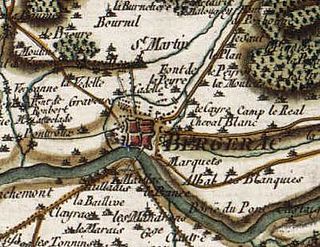
The Battle of Bergerac was fought between Anglo-Gascon and French forces at the town of Bergerac, Gascony, in August 1345 during the Hundred Years' War. In early 1345 Edward III of England decided to launch a major attack on the French from the north, while sending smaller forces to Brittany and Gascony, the latter being both economically important to the English war effort and the proximate cause of the war. The French focused on the threat to northern France, leaving comparatively small forces in the south-west.

The Gascon campaign of 1345 was conducted by Henry, Earl of Derby, as part of the Hundred Years' War. The whirlwind campaign took place between August and November 1345 in Gascony, an English-controlled territory in south-west France. Derby, commanding an Anglo-Gascon force, oversaw the first successful English land campaign of the war. He twice defeated large French armies in battle, taking many noble and knightly prisoners. They were ransomed by their captors, greatly enriching Derby and his soldiers in the process. Following this campaign, morale and prestige swung England's way in the border region between English-occupied Gascony and French-ruled territory, providing an influx of taxes and recruits for the English armies. As a result, France's ability to raise tax money and troops from the region was much reduced.
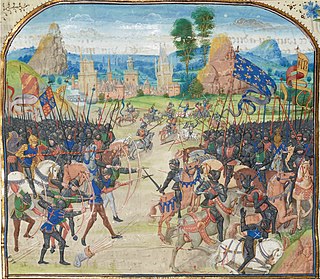
The Black Prince's chevauchée of 1356 was a large-scale mounted raid by an Anglo-Gascon force under the command of Edward, the Black Prince, between 4 August and 2 October 1356 as a part of the Hundred Years' War. The war had broken out in 1337, but a truce and the ravages of the Black Death had restricted the extent of the fighting since 1347. In 1355 the French king, John II, determined to resume full-scale war. That autumn, while Edward III of England threatened northern France, his son, Edward of Woodstock, later known as the Black Prince, carried out a devastating mounted raid, or chevauchée: an Anglo-Gascon army marched from the English possession of Gascony 675 miles (1,086 km) to Narbonne and back. The French refused battle, despite suffering enormous economic damage.

The Black Prince's chevauchée, also known as the grande chevauchée, was a large-scale mounted raid carried out by an Anglo-Gascon force under the command of Edward, the Black Prince, between 5 October and 2 December, 1355 as a part of the Hundred Years' War. John, Count of Armagnac, who commanded the local French forces, avoided battle, and there was little fighting during the campaign.
Lancaster's chevauchée of 1356 in Normandy was an English offensive directed by Henry, Duke of Lancaster, in northern France during 1356, as a part of the Hundred Years' War. The offensive took the form of a large mounted raid – a chevauchée – and lasted from 22 June to 13 July. During its final week the English were pursued by a much larger French army under King John II that failed to force them to battle.

The siege of Breteuil was the investment of the Norman town of Breteuil, held by partisans of Charles II, King of Navarre, by French forces. It lasted from April to about 20 August 1356. It was interrupted on 5 July when a small English army commanded by Henry, Earl of Lancaster relieved and resupplied it. The French king, John II, attempted to bring Lancaster to battle with the much larger French royal army, but Lancaster marched away and the attempt failed. John then renewed the siege of Breteuil.

English offensives in 1345–1347, during the Hundred Years' War, resulted in repeated defeats of the French, the loss or devastation of much French territory and the capture by the English of the port of Calais. The war had broken out in 1337 and flared up in 1340 when the king of England, Edward III, laid claim to the French crown and campaigned in northern France. There was then a lull in the major hostilities, although much small-scale fighting continued.













